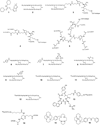The intricate role of CXCR4 in cancer
- PMID: 25287686
- PMCID: PMC4322894
- DOI: 10.1016/B978-0-12-411638-2.00002-1
The intricate role of CXCR4 in cancer
Abstract
Chemokines mediate numerous physiological and pathological processes related primarily to cell homing and migration. The chemokine CXCL12, also known as stromal cell-derived factor-1, binds the G-protein-coupled receptor CXCR4, which, through multiple divergent pathways, leads to chemotaxis, enhanced intracellular calcium, cell adhesion, survival, proliferation, and gene transcription. CXCR4, initially discovered for its involvement in HIV entry and leukocytes trafficking, is overexpressed in more than 23 human cancers. Cancer cell CXCR4 overexpression contributes to tumor growth, invasion, angiogenesis, metastasis, relapse, and therapeutic resistance. CXCR4 antagonism has been shown to disrupt tumor-stromal interactions, sensitize cancer cells to cytotoxic drugs, and reduce tumor growth and metastatic burden. As such, CXCR4 is a target not only for therapeutic intervention but also for noninvasive monitoring of disease progression and therapeutic guidance. This review provides a comprehensive overview of the biological involvement of CXCR4 in human cancers, the current status of CXCR4-based therapeutic approaches, as well as recent advances in noninvasive imaging of CXCR4 expression.
Keywords: CXCL12; CXCR4 inhibitor; CXCR4 tracers; Cancer therapy; Chemokine receptor; Chemotaxis; Metastasis; Molecular imaging; PET–CT; Therapeutic intervention.
© 2014 Elsevier Inc. All rights reserved.
Figures



References
-
- ACS. Cancer facts and figures 2014. Atlanta, GA: American Cancer Society; 2014.
-
- Ahr B, Denizot M, Robert-Hebmann V, Brelot A, Biard-Piechaczyk M. Identification of the cytoplasmic domains of CXCR4 involved in Jak2 and STAT3 phosphorylation. Journal of Biological Chemistry. 2005;280(8):6692–6700. - PubMed
-
- Aiuti A, Webb IJ, Bleul C, Springer T, Gutierrez-Ramos JC. The chemokine SDF-1 is a chemoattractant for human CD34+ hematopoietic progenitor cells and provides a new mechanism to explain the mobilization of CD34+ progenitors to peripheral blood. Journal of Experimental Medicine. 1997;185(1):111–120. - PMC - PubMed
Publication types
MeSH terms
Substances
Grants and funding
LinkOut - more resources
Full Text Sources
Other Literature Sources
Research Materials

